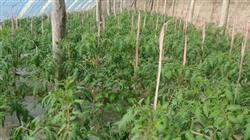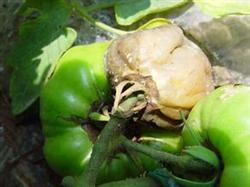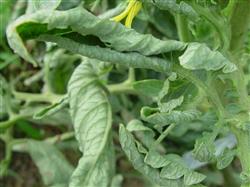Tomato should be cautious in the use of Zhuangzhang.

In recent years, many farmers have used hormones such as testosterone when chemical control tomato. However, due to improper use of auxiliary strong element, often resulting in small fruit, cracked fruit, green top and other phenomena. Therefore, it is suggested that tomato chemical control should be based on nutrition regulation, and attention should be paid to prevent the following situations from happening. 1. "Small fruit disease": Because farmers use large doses of Zhuzhuangsu (or Aifengwang) at tomato seedling stage and late time (generally at "high foot seedling"), although plant height is controlled, fruit cluster development is also inhibited. At this stage, the "rooting and seedling method" should be adopted. The specific method is as follows: 500 - 800 times of high quality organic humic acid active liquid fertilizer is selected to irrigate roots, 100 - 150 grams of liquid medicine is used for each plant, and Wanchun plant growth agent is sprayed in addition to hymexiline or Lvheng No.1 to promote root development and improve disease resistance. 2. "Fruit cracking disease": the use of Zhuzhuang element chemical control, can make the pericarp thickened, so that the rapid expansion of pulp, thus forming "fruit cracking disease." To prevent this disease, boron, calcium and temperature should be increased. Specifically, 300~500 times solution of boron calcium humate or 300~500 times solution of Gaomei should be sprayed at tomato flowering stage, and Zhuanggenkalibao should be applied with small fertilizer water. 3. "Green top disease": due to some farmers increased fertilizer, water, temperature management, so that fruit development too fast, coupled with the use of hormone spraying uneven, resulting in uneven development of various parts of the fruit, the formation of "green top disease." The method of root cutting and cooling should be adopted to control it. specifically, when that tomato grow the second and third ears of young fruit, biological organic fertilizer and potassium sulfate compound fertilizer are applied in furrows or hole to promote the growth of secondary roots, cultivate fertilizer absorption and water absorption capacity, and lay a good foundation for the later stage of growth.
- Prev

Symptoms and Chemical Control of Tomato Acid Rot
At present, symptoms only occur in a few areas. It is only harmful to fruits, and most of them are overripe fruits, especially those with wounds are the most susceptible to disease. The part of the disease softens, the epidermis turns brown, wet rot wrinkles, and there are fine cracks. Sparse white mildew appeared on the surface of the disease when the humidity was high. In the end, the diseased fruit is dripping, rotten and sour. The law of the disease.
- Next

What is the reason for curling tomato leaves?
There are many reasons for curling tomato leaves, there are mainly the following: 1, virus. Virus diseases are generally transmitted by aphids, whitefly and other virus-transmitting insects. The susceptible plants are short and the leaves are curly and clustered. In severe cases, there are only veins and no mesophyll in the leaves. Prevention and treatment: in addition to the selection of anti-virus varieties, the implementation of rotation, in the early stage of the disease, spraying.
Related
- Where is it suitable to grow horseradish in China? it is expected to see the middle altitude horseradish in Alishan.
- How to prevent tomato virus disease reasonably? (Control methods included)
- Many people like to plant towel gourd on the balcony. What are the main points of this method and management?
- What crops can chili peppers be mixed with?
- Fertilization techniques and matters needing attention in Tomato
- What are the grafting techniques for peach seedlings in spring?
- Harm and control methods of root swelling disease of Chinese cabbage
- What are the pests of sweet potatoes? How to prevent and cure it?
- Symptoms, causes and Control methods of navel Rot in Tomato
- The cause of "Cucumber rotten bibcock" in Farmers' planting Cucumber and its Control Plan

